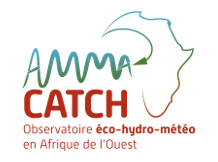Background
The intrinsic inter-annual variability of the water cycle and the dynamics of the associated vegetation is strongly impacted by human activities, whether by climate change induced by greenhouse gas emissions (GHG), or by changes in land use, practices or uses. These disturbances are driving eco-hydrosystems towards new balances, the trajectories of which must be predicted so that the actors can make the necessary decisions in terms of adaptation.
In West Africa, the great drought of the 1970s and 1980s, particularly intense and long in the Sahel, was the strongest climatic signal observed in the 20th century. Combined with the impacts of global warming observed for more than four decades, and the increase in anthropogenic pressure on eco-hydrosystems due to the region’s strong demographic growth (2.7% per year : doubling of the population in 25 years), these changes triggered a cascade of processes that led to an intensification of the hydrological cycle in all the compartments of the Critical Zone (ZC).
The recent floods in the major Sahelian cities of Chad in Mali in 2020, in Grand-Bassam (Côte d’Ivoire) and Bamako (Mali) in 2019, and in Ouagadougou (Burkina-Faso) in 2018 are the consequences.
Updated on 26 janvier 2022





